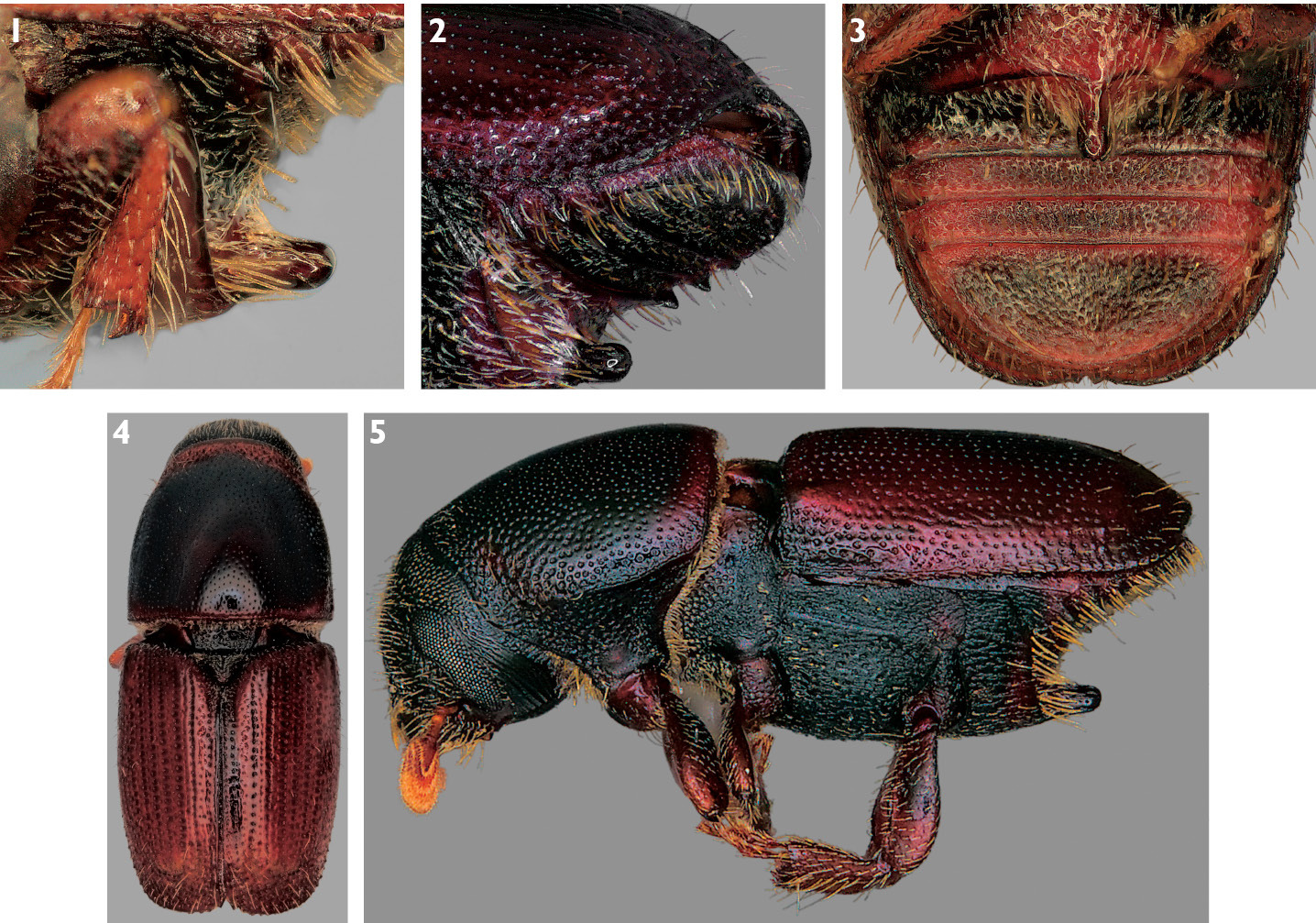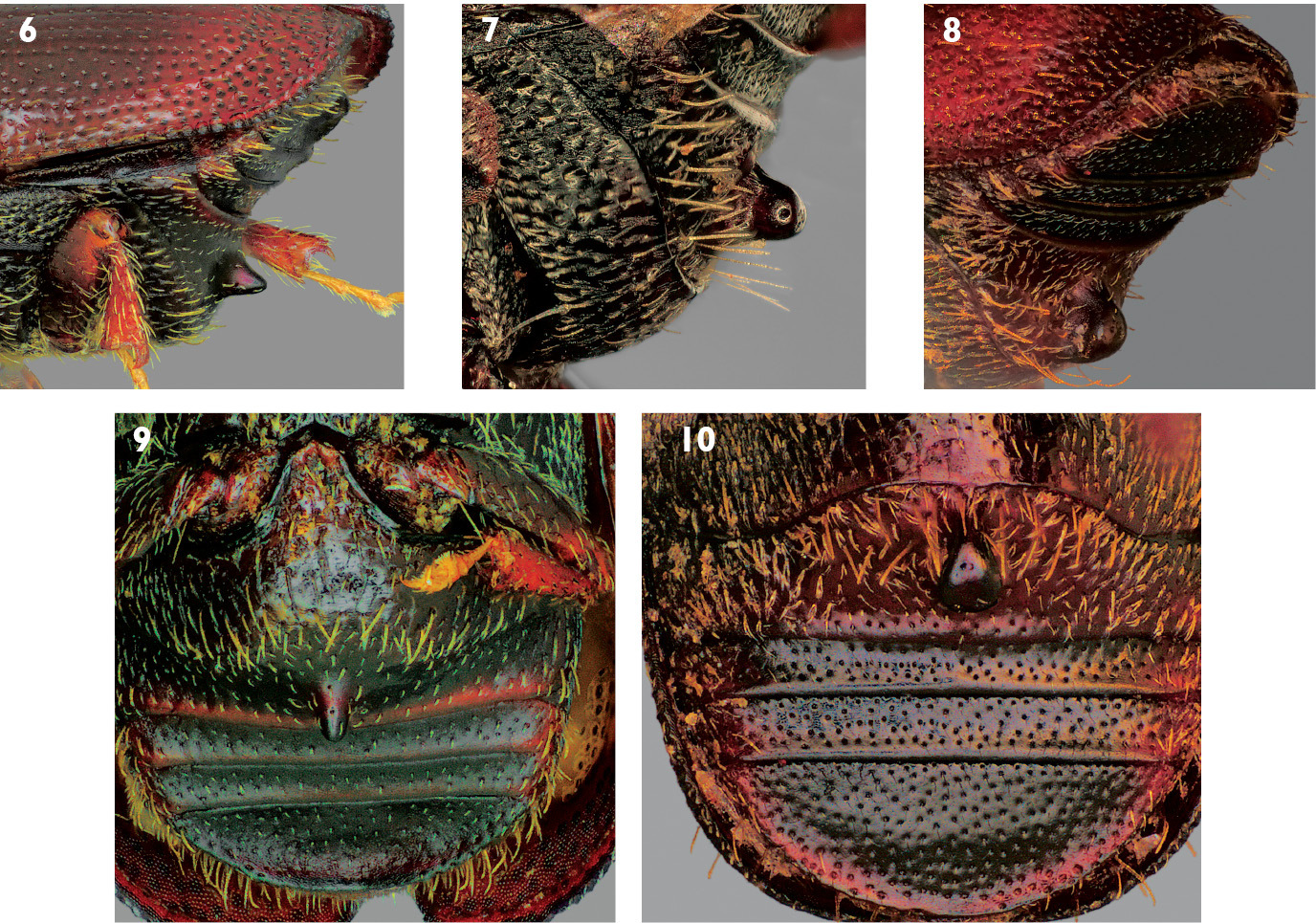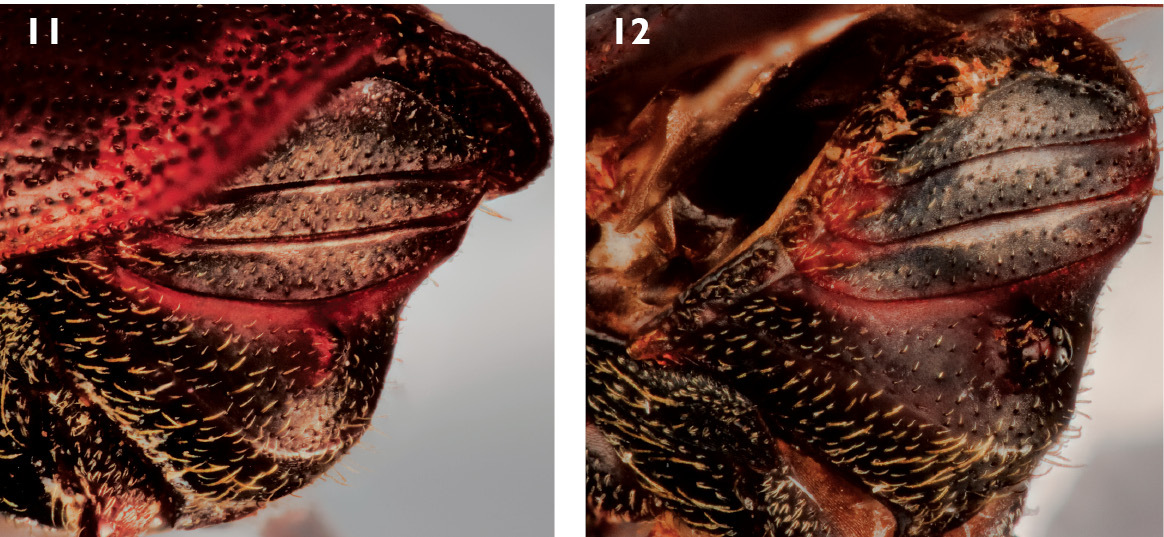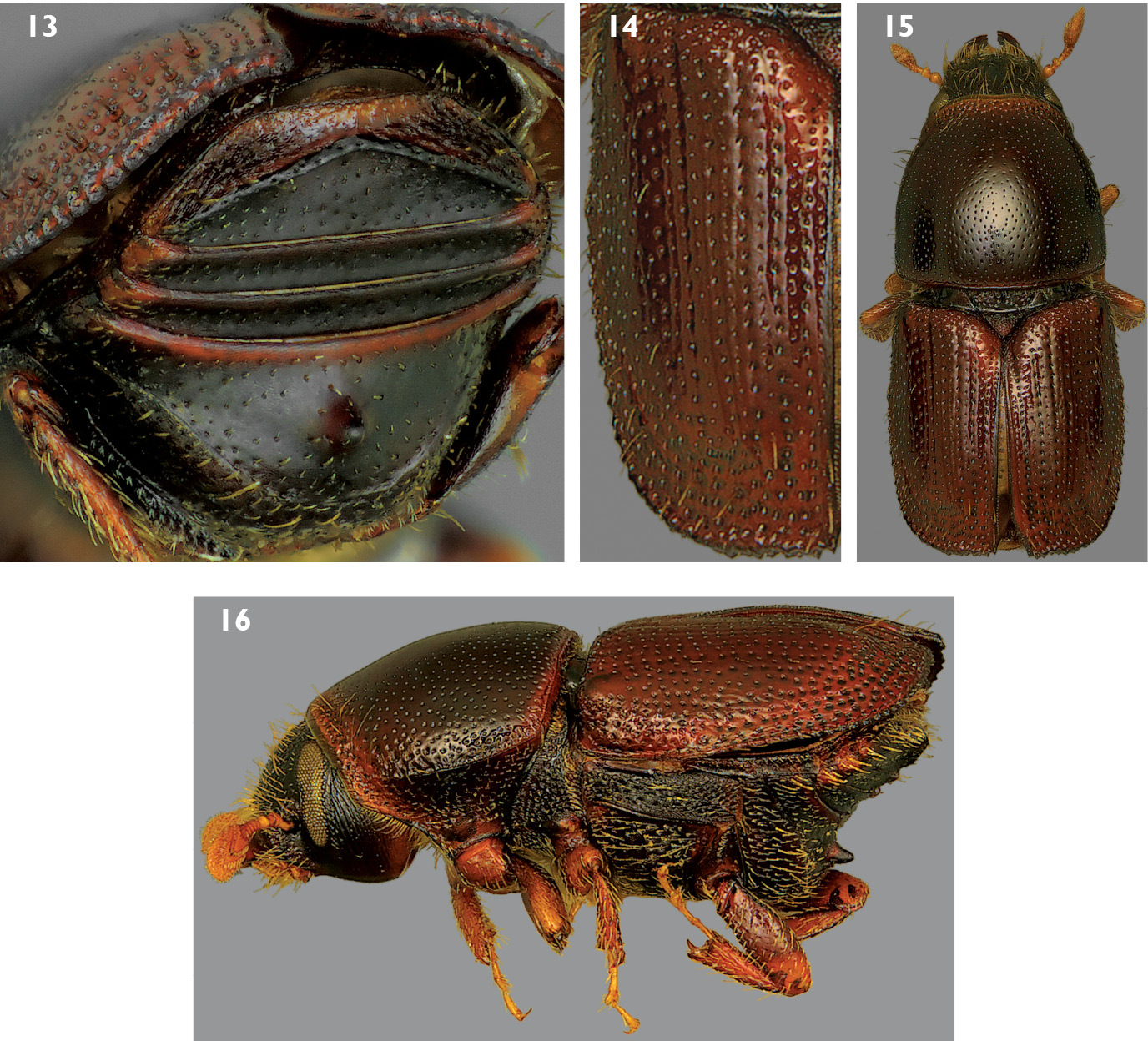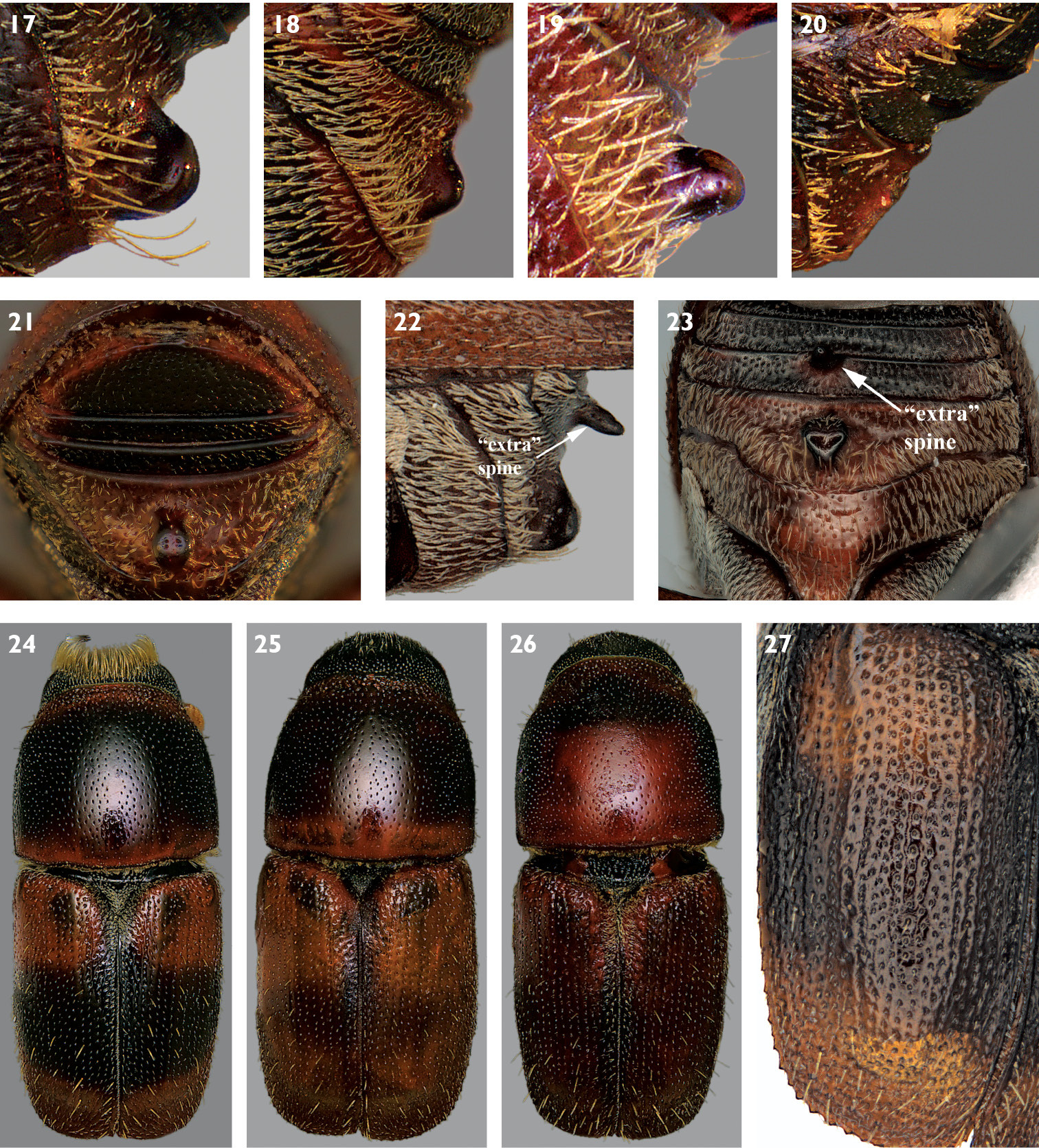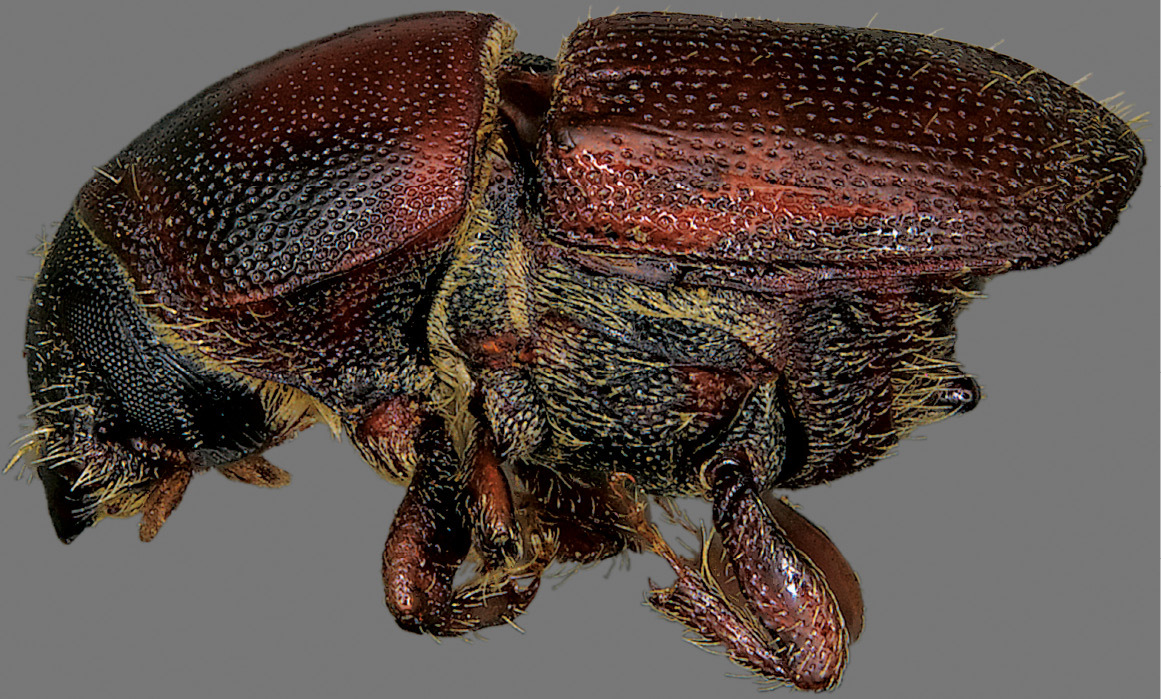(C) 2010 James R. LaBonte. This is an open access article distributed under the terms of the Creative Commons Attribution License, which permits unrestricted use, distribution, and reproduction in any medium, provided the original author and source are credited.
For reference, use of the paginated PDF or printed version of this article is recommended.
In 2003, an Asian bark beetle, Scolytus schevyrewi Semenov (Coleoptera: Curculionidae: Scolytinae), the banded elm bark beetle, was detected for the first time in North America. This paper modifies the
Scolytus schevyrewi, banded elm bark beetle, exotic species, Scolytinae
A growing number of exotic wood boring or wood associated
beetles have recently been found to be established in North America
(e.g.,
As the cooperating taxonomist for the western states
participating in the 2003 EDRR program, specimens from Lindgren funnel
traps used in this survey were sent to me for identification. Early
samples from the Denver, Colorado, metropolitan area contained several
specimens of a species of Scolytus Geoffroy unfamiliar to me and that I was unable to key to any species in
Subsequent trapping found this species to be abundant and
clearly established in Denver and Ogden. These data stimulated
extensive trapping surveysthroughout Colorado and Utah, where it was
found at most sites. The realization that Scolytus schevyrewi
was widely distributed in Colorado and Utah prompted several
neighboring states to initiate surveys as well. At the end of 2003, Scolytus schevyrewi had been detected in twelve additional states (
Existing taxonomic treatments for North American Scolyus (
The diagnostic characters used to differentiate Scolytus schevyrewi from other species of Scolytus are mainly based on specimens acquired via the EDRR project and a variety of wood boring insect surveillance programs, most funded via the USDA Cooperative Agricultural Pest Survey (CAPS) program. I have examined over 7, 600 specimens of Scolytus schevyrewi from these surveys.
Distinguishing Scolytus schevyrewi from other species of Scolytus in North and Central America
The following modifications to Wood’s (1982) key to the species of Scolytus in North and Central America will serve to identify typical specimens of Scolytus schevyrewi. Very little of the text in his key remains in the couplets below, other than the distributions, hosts, and size ranges for species dealt with therein. Several characters used in his key to discriminate among these species are not used because they are unnecessary or lead to an unduly cumbersome key, are too variable, or cannot be accurately assessed without reliably identified reference specimens, a resource many users of this key will lack. These characters can include the relative sizes of interstrial and strial punctures, whether the elytral interstriae are impressed, and subtle differences in size among abdominal sternal punctures.
| 8(7) | Sternum 2 with base of spine touching its anterior margin (Fig. 1); posterolateral margins of sterna 2–4 each bearing small, distinct, sharply pointed tubercles (those on sternum 4 often obscured by elytra) (Fig. 2); median posterior margin of sternum 1 convex (Fig. 3); elytra unicolorous brown (Fig. 4); British Columbia and Nova Scotia to California and Florida to California and Florida; Ulmus; 1.9–3.1 mm (dorsal habitus Fig. 4, lateral habitus Fig. 5) | Scolytus multistriatus (Marsham) |
| – | Sternum 2 with base of spine remote from its anterior margin (Figs 6, 7); posterolateral margins of sterna 2–4 lacking tubercles (Figs 6, 8); median posterior margin of sternum 1 convex (Fig. 9) or concavely truncate (Fig. 10); in coniferous or deciduous hosts | 9 |
| 9(8) | Spine on sternum 2 with base remote from posterior margin of segment (Figs 6, 7) | 9a |
| – | Spine on sternum 2 in contact with posterior margin of segment (Figs 11, 12) | 10 |
| 9a | Spine on sternum 2 narrowly conical and sometimes pointed at apex in lateral (Fig. 6), ventral (Fig. 9), and apical (Fig. 13) views; median posterior margin of sternum 1 convex (Fig. 9); last abdominal sternum with transverse carinae distant from apex (Fig. 13); elytra unicolorous brown (Figs 14, 15); interstriae not impressed and diameter of interstrial punctures less than those of striae (Fig. 14); pronotum dark with at most very narrow pale banding along anterior and posterior margins (Fig. 15); Alaska and Nova Scotia to California and New York; Picea and, rarely, Larix; 2.2–2.8 mm (dorsal habitus Fig. 15, lateral habitus Fig. 16) | 7. Scolytus piceae (Swaine) |
| – | Spine on sternum 2 variable, from almost
absent to strongly developed, but most often broadly conical and blunt
at apex in lateral view (Figs 17–20), apex often broader than base in ventral view (Fig. 10) and flattened in apical view (Fig. 21); occasional aberrant specimens with a spine on sternum 2 and a second spine on sternum 3 (Figs 22, 23); median posterior margin of sternum 1 emarginate or truncate (Fig. 10); last abdominal sternum with transverse carina very near apex (Fig. 21); elytra almost always with dark median band, with bases and apices pale (Figs 24, 25) although this band may be indistinct (Fig. 26); interstriae often impressed and diameter of interstrial punctures subequal to those of striae (Fig. 27); pronotum generally with relatively extensive pale coloration (Figs 24–26);
currently known from most of the coterminous states in the U.S.A.
(except for the southeastern states) and from southern Canada; deciduous
hosts (known only from Ulmus in North America); 2.7–4.3 mm (dorsal
habitus Figs 24–26, lateral habitus Fig. 28) (not in |
Scolytus schevyrewi Semenov |
1 Lateral view of spine on abdominal sternum 2 of Scolytus multistriatus 2 Lateral view of abdominal sterna of Scolytus multistriatus, showing lateral tubercles 3 Ventral view of abdominal sterna of Scolytus multistriatus 4 Dorsal habitus of Scolytus multistriatus 5 Lateral habitus of Scolytus multistriatus.
1 Lateral view of abdominal sterna of Scolytus piceae 7 Lateral view of abdominal sterna of Scolytus schevyrewi 8 Oblique lateral view of abdominal sterna of Scolytus schevyrewi 9 Ventral view of abdominal sterna of Scolytus piceae 10 Ventral view of abdominal sterna of Scolytus schevyrewi.
11 Oblique lateral view of abdominal sterna of female Scolytus unispinosus LeConte 12 Oblique lateral view of abdominal sterna of male Scolytus unispinosus LeConte.
13 Posterior view of abdominal sterna of Scolytus piceae 14 Dorsal view of left elytron of Scolytus piceae 15 Dorsal habitus of Scolytus piceae 16 Lateral habitus of Scolytus piceae.
17-20 Variation in spine on abdominal sternum 2 of Scolytus schevyrewi 21 Posterior view of abdominal sterna of Scolytus schevyrewi 22 Lateral view of abdominal sterna of Scolytus schevyrewi with two abdominal spines 23 Posterior view of abdominal sterna of Scolytus schevyrewi with two abdominal spines 24–26 Dorsal habitus and variation in elytral and pronotal coloration of Scolytus schevyrewi 27 Dorsal view of left elytron of Scolytus schevyrewi.
Lateral habitus of Scolytus schevyrewi.
Typical specimens of Scolytus schevyrewi cannot be easily confused with any other species of Scolytus known from North America. The shape and position of the spine on sternum 2 (Figs 7–8, 10, 17–21), especially in males, and typical coloration (Figs 24–26) are unique relative to all other North American species. However, this is a highly variable species and it is advisable to use a suite of characters for its identification. The following elaboration on variation in Scolytus schevyrewi is based upon the examination of thousands of specimens of that species and of Scolytus multistriatus, the species most apt to be confused with Scolytus schevyrewi.
There can be great variation in the shape and position of the spine on sternum 2. Males most often have the spine well developed, with a blunt apex that is broader than the base, appearing triangular in ventral view (Fig. 10). Especially with females, this feature can be variously reduced, becoming almost absent in the most extreme cases (Fig. 20). Reduction of the spine can lead to possible confusion with specimens of Scolytus multistriatus that have malformed or broken spines, which are not uncommon in large series thereof. However, as indicated previously, in Scolytus schervyrewi, the base of the spine on sternum 2 is remote from the anterior margin, almost at the center, whereas in Scolytus multistriatus the base of the spine is in contact with the anterior margin. Some Scolytus schevyrewi, especially those with larger spines, can have the base of the spine positioned anterior of the center of sternum 2, compounding the possibility of confusion with aberrant Scolytus multistriatus. Inadequately cleaned Scolytus multistriatus may have debris under the base of the spine, which can make its lateral appearance broader than is the case. An extreme example of abdominal spine variation in Scolytus schevyrewi is exhibited in a male from California (courtesy of R.L. Penrose, California Department of Food and Agriculture) (Figs 22, 23). In this instance, a second, accessory, sharply conical spine is present on the third abdominal sternum. This spine is asymmetrically positioned (Fig. 23), leading to my conclusion that this specimen represents a developmental aberration rather than a different species. In all other respects, this specimen appears to be a typical Scolytus schevyrewi.
The elytron of a normal Scolytus schevyrewi is distinctively colored, with a variably developed median dark band and the base and apex distinctly pale (Figs 24, 25). This character enables rapid identification of this species as no other North American species has this color pattern. The dark median band is best observed in well dried specimens; it can be obscured in specimens still damp from collecting in liquid or storage in alcohol. However, there are occasional specimens with apparently unicolorous dark or pale elytra (Fig. 26). Some samples exhibited higher proportions of these unicolorous specimens, but probably less than 10%. The existence of individuals with concolorous elytra dictates caution in complete reliance upon color for identification of Scolytus schevyrewi, as both Scolytus multistriatus and Scolytus piceae normally have concolorous elytra. Some Scolytus multistriatus also have elytra with dark apices and bases, with pale median areas.
The pronotum of a typically colored Scolytus schevyrewi is also distinctively colored, with relatively extensive areas of pale coloration (Figs 24–26). The extent of the pale areas is highly variable. The most common pattern is a fairly broad pale band along the posterior margin with a somewhat narrower pale band along the anterior margin (Figs 24, 25). Many specimens have the pale coloration extending from the posterior margin into the median area (Fig. 26). This pale coloration can sometimes cover almost the entire dorsum of the pronotum. On the other hand, in some specimens the pronotum is essentially completely dark, with only hints of anterior and posterior pale marginal banding. The extent of pale pronotal coloration appears independent of the size and extent of the median dark elytral band and the darkness of the ground color of the elytra. Several of the specimens of Scolytus multistriatus I’ve examined have large, nebulously paler areas in the median area of the pronotum. As with elytral coloration, pronotal coloration should be used with some caution to distinguish Scolytus schevyrewi from Scolytus multistriatus and Scolytus piceae.
As indicated in the key, specimens of Scolytus schevyrewi average larger than either Scolytus multistriatus or Scolytus piceae. However, small Scolytus schevyrewi fall within the size range of both of the other species. Furthermore, large Scolytus multistriatus approach the size of average or even large Scolytus schevyrewi.
Specimens of Scolytus multistriatus have distinct, pointed tubercles or “teeth” on the posterior lateral margins of sterna 2–4 (Fig. 2). Specimens of Scolytus piceae and Scolytus schevyrewi lack this feature (Figs 6, 8). This character is occasionally obscured in specimens of Scolytus multistriatus swollen with liquid preservatives, but it can normally be observed by examining the lateral margins of the sterna from an oblique perspective.
The posterior margin of sternum 2 is distinctly truncate or slightly emarginate in almost all Scolytus schevyrewi examined (Fig. 10). On the other hand, in Scolytus multistriatus (Fig. 3) and Scolytus piceae (Fig. 9) the posterior margin of sternum 2 is normally slightly to pronouncedly convex and in Scolytus multistriatus is often slightly produced at the base of the spine (Fig. 3).
The elytron of a Scolytus schevyrewi specimen in good condition typically displays three rows of relatively stout, long, discal setae that are about twice as long as the width of the elytral intervals (Figs 24–26). The elytra of most Scolytus multistriatus lack distinct rows of discal setae, although there are generally setae at the elytral apices and there may be discal setae (Fig. 4). If discal setae are present, they are generally scattered, are less stout than those of Scolytus schevyrewi and are shorter, about as long as the width of the elytral intervals. Of the small series of Scolytus piceae examined, most lacked discal setae (Fig. 14). A few specimens had a row of 3 or 4 discal setae on interval 7, but these setae were short and fine, similar to those of Scolytus multistriatus.
On visble abdominal sterna 3–5, the setae of Scolytus schevyrewi are short and recumbant (Figs 8, 10). Those of Scolytus piceae are even shorter, often difficult to discern, and are also recumbant (Figs 6, 9). In contrast, specimens of Scolytus multistriatus often have long, semi-erect setae on these sterna, especially on sternum 5 (Figs 2, 3).
In summary, a suite of characters is best used to reliably identify Scolytus schevyrewi. Especiallly with regard to Scolytus multistriatus, these include (more or less in order of reliability and ease of assessment) the shape and position of the spine on sternum 2, normal elytral and pronotal coloration, the absence of lateral teeth on sterna 2–4, average size, the truncate or slightly emarginate posterior margin of sternum 2, relatively abundant and large discal elytral setae, and short, recumbant setae on sterna 3–5.
DiscussionThe U.S. specimens collected prior to 2003, along with the extensive U.S. distribution of Scolytus schevyrewi
and its great abundance in many areas, provide ample evidence that
this exotic species is not new to the U.S. but is instead a legacy
species that has been present for decades. Such legacy species, e.g., Xyleborinus alni (Niisima) (
There are profound taxonomic challenges presented by the
remaining pool of undetected legacy species, truly newly introduced
exotics, and the onslaught of continued new introductions as a
consequence of global trade. Almost all existing taxonomic works for
scolytines in North America, let alone other taxa of wood boring or
wood associated insects, quite reasonably treat only those species
previously known from this continent. The taxonomic infrastructure
available to support surveillance for a wide spectrum of exotic wood
borers has been eroding for decades and may have declined below critical
and self sustaining levels. New technologies, such as extended depth
of field macroscopy and LUCID™ go far to bridge this taxonomic
impediment, e.g., a recent guide to the North American Siricidae (
Stephen L. Wood identified the first EDRR specimens of Scolytus schevyrewi schevyrewi. He was also very generous with his time with regard to identifications of other challenging scolytines. North American Scolytinae taxonomy would be unrecognizable without his contributions. I will sorely miss him.
Donald E. Bright, who has also contributed mightily to North American scolytine taxonomy, confirmed Dr. Wood’s identification of the initial EDRR specimens of Scolytus schevyrewi. I am very grateful to him for his generosity and taxonomic support. Natalia J. Vandenberg also confirmed Dr. Wood’s initial identification.
My long-suffering friends and colleaagues, E. Richard Hoebeke and Robert J. Rabaglia, reviewed many versions of this manuscript and offered much valuable advice to improve it, as well as relentless prodding me to complete it. Several of my ODA colleagues, especially Joshua A. Vlach, provided valuable insights as well.
I am grateful to those USFS colleagues who invited me into the EDRR fold early on, especially Donald A. Duerr and Iral R. Ragenovich.
I could not have recognized the significant characters and intraspecific variability of Scolytus schevyrewi without the extensive set of specimens provided to me through surveys supported through, and in many cases conducted by, USDA APHIS-PPQ and Forest Service. These surveys were also often conducted by colleagues in state agencies of agriculture and forestry, including many of my local colleagues of the Oregon Department of Agriculture.
Last, but certainly not least, my profound thanks to the Oregon Department of Agriculture for use of our wonderful extended depth of field imaging system and the exemplary talents of Steven A. Valley, who acquired the marvelous images used in this paper.







